Introduction
All international organizations have or tend to engage in complex procurement and operational processes. Saudi Aramco, which is an international organization, uses a rigid procurement process that inhibits expeditious operations and functioning. Due to the broad customer base and wide geographical distribution, procurement practice in Saudi Aramco is complicated even further. The lengthy procurement procedure details slow down product production, distribution, sales, and it reduces the actual production potential of the organization.
Saudi Aramco Procurement process
Generally, Aramco materials are imported from several countries depending on the cost of raw materials, ease of accessibility, and availability of transportation facilities to the nearest manufacturing site. Respective logistics managers evaluate all these variables. It is the work of respective managers, who are required to assess the viability of the procedure before recommending the appropriate action to the department.
Along the bureaucratic hierarchy, the reports by logistics managers are sent to regional managers who deliberate on the issues and come up with concrete procurement decisions within. The procurement departments are located in Europe, the US, Japan, and other locations. The regional managers in the different locations decide on design specifications and required materials. Once the development design is prepared, it is usually sent to the shortlisted manufacturers for additional instructions and product specifications.
The construction division acquires raw materials and merchandise from production zones such as the UK and Saudi Arabia. The purchasing division under the procurement department takes care of purchases, apparatus service, and inspections. In addition, the procurement department oversees the general surveillance and general transportation of materials and apparatus from factories to the worksite. Concerning the procurement process, the procurement department makes bid lists according to contract agreements. On the other hand, the purchasing department follows up the entire processes, which include tendering, awarding, and governing of purchase orders. It is also the role of this department to check the quality as well as organizing for shipment and other related processes.
The long, complex, and detailed procurement process that is exercised by the organization is a source of unnecessary delays that lead to production stagnation. Thus, the organization needs to restructure the entire process to allow speedy operations and overall production. An overhaul of the complex system will enable the organization to increase its profit margins and enhance customer loyalty through the superior and speedy delivery process. Based on the complex nature of the problem, I undertook to address it using the Soft System Method (SSM). This approach best fits the scenario and the organization since it will be possible to reduce the long procedure and lengthy details involved.
Analysis
Saudi Aramco’s procurement process requires to be addressed speedily as a measure to overcome inherent bottlenecks. Lack of proper and effective procurement procedures have cost the organization a lot of income due to delays that slow operations. However, this problem can be resolved by the use of Software System Method. The approach is effective since its implementation helps to solve the very nature of the problem. Furthermore, the approach is able to meet the needs of managers, customers, managers, international regulators, and other stakeholders in the organization with ease. The essence of using the soft system method is its ability to accommodate several stakeholders without any complexities.
CATWOE Analysis
Root Definition
Root definition is a statement that provides element functions in the system. Forbes (1995, p. 8) explains the root definition as the activity and the reason why it is perceived high in the system. The intended system aims at integrating the organization’s goals, objectives, and strategic plan in a simplified manner to provide solutions to the organization’s procurement department. Moreover, the system also addresses the shortcomings that were experienced by the initial system. Similarly, the new system is developed in a way that makes it applicable in other similar organizations with minimal customization.
Ethicality statement
The intended system will help in simplifying the compound procurement process that is being used by the Saudi Aramco. The simplification will be achieved because the new system will help in hastening decision making process as well as enhancing all the stakeholders’ access to the organization’s information online. Furthermore, the system demands the incorporation of all stakeholders in its development and therefore it is an all-inclusive system.
Decide With Stakeholders Approach
The criterion that is used when deploying this design is decided with and for other stakeholders. Thus, I was compelled to involve other stakeholders in decision-making. The first thing that was expected of us was to engage in a brainstorming session to give an in-depth appraisal of the current situation. After the brainstorming session, the stakeholders and I came up with criteria of simplifying complex problems. Later the group decided to organize the assembled information into a rich picture diagram and eventually into a conceptual model that shows how the entire process will be aggregated. The entire process is represented as shown in the table below.
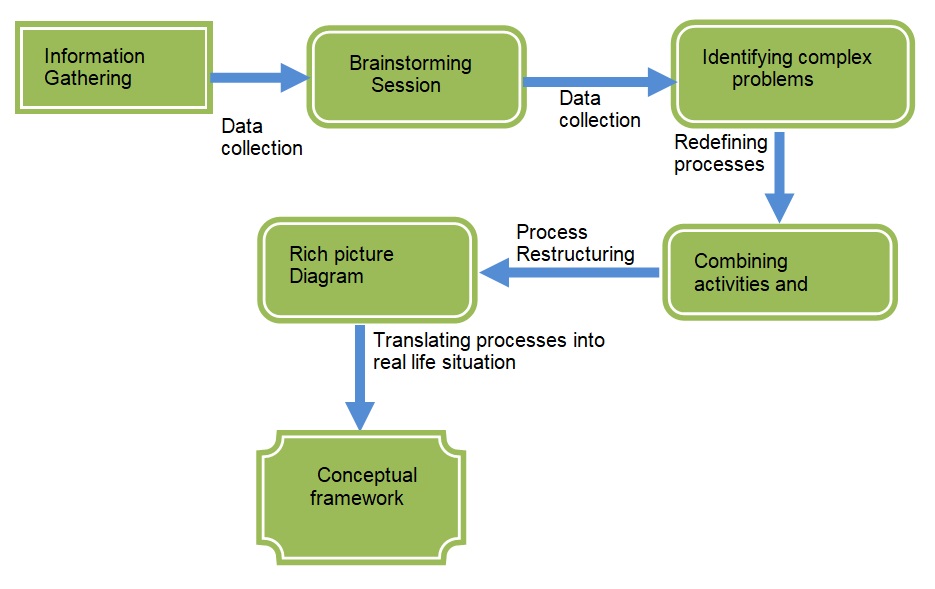
Solution Formulation Process: Soft System Method (SSM)
Hitchson (1997, p. 26), highlights that the detailed methodology used in developing SSM needs not to be fixed or rigid. It is desirable that the methodology is flexible, which allows for repetition and alteration of previous phases. These processes are intermittent in nature and the preceding step depends on the previous stage.
Problem Situation
This is the preliminary stage, which requires the stakeholders to articulate the underlying problem. The management needs to gather all the information that is relevant or pertaining to the existing problem. At this stage all the information related to procurement procedure from various sources such as the internet, Library, organizations journals and management guidebooks is gathered. Some information was also obtained form reports of previous benchmarking sessions that were done by the organization. The information was retrieved from the organization website and other web related sources.
Data Gathering Interface
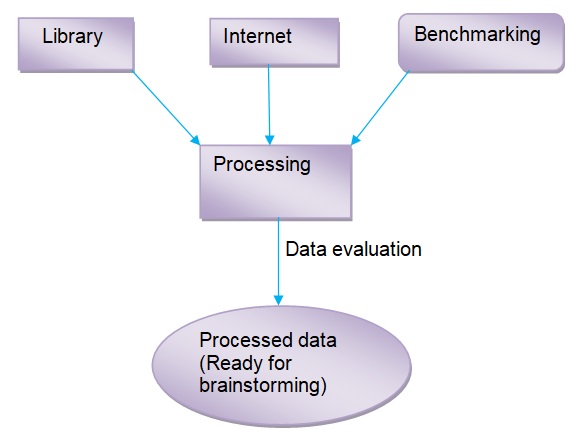
This stage allowed me to come up with the rich picture diagram that included both the hard aspect as well as the soft aspects. The hard aspect entailed detailed information about the organization structure, facts and statures that is adopted by the organization while the soft aspect include the managers opinions, guesses, judgment and social roles. The wide approach assumed help in generating solution that is well informed and all-inclusive.
Conceptual Model
At this stage, a diagrammatical representation of the system was drawn to reflect how the system would help to incorporate all the stakeholders. All the operations were linked with the operations that were to be undertaken by each group. The system is designed to provide automated feedback to the other stakeholders to allow congruence and speedy information transmission. For instance, all the contractors are able to update their profiles online while the suppliers are able to view the quotation of other suppliers. With this online system the organization will be able manage all the current orders and project the new level of operation. Other agents in distant parts of the world are also in a position to update into the system about price changes and availability of raw material for timely arrangement of purchases.
Lack of automation in the previous system has not only affected the organizational productivity but it has also denied the customers and other stakeholders’ right to access products at the right time. Furthermore, the organization has also struggled to obtain up to date market information in terms of opportunities and strategically positioning for competition. However, the new system will require advance information technologies skills that will enable employee to operate the system.
Examination
Delivery mechanism
All the processes and procedures identified in the conceptual model are assessed to develop a series of sequences and that fit the real world situations. At this stage, the processes identified are appraised against the rigid procurement that has been used. The firm’s procedures that have been in use are replaced by dynamic operations that include connecting regional branches using a vibrant telecommunication system to reduce time taken during the decision-making process.
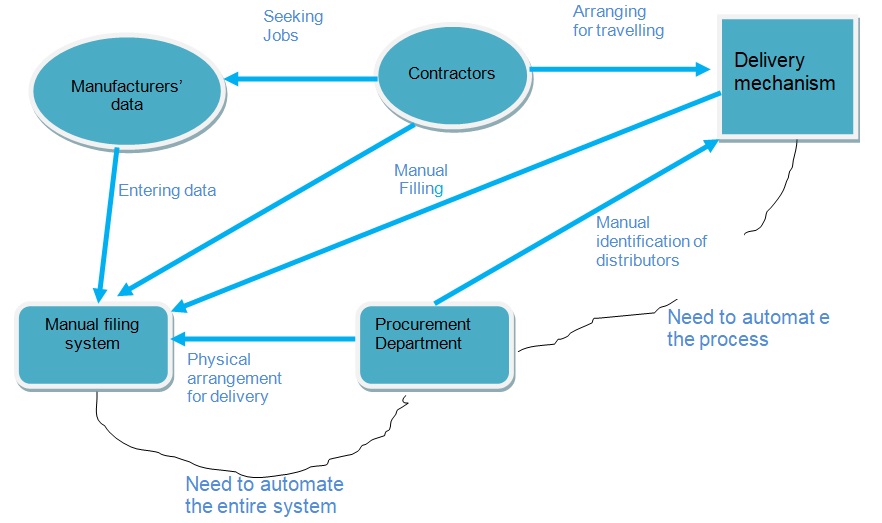
A diagram showing automation manual processes
Comparison
Generally, most conceptual frameworks seem effective theoretically but are rarely operational. To overcome this predicament, the new system has been designed in way that makes it practical in real life. Each activity is organized in a manner applicable to the real world operation. For instance, all bids received are queried against the offer presented by various contractors to obtain the best bids. The option to provide instantaneous feedback to all stakeholders meets the needs of each person who require ready instantaneous response. However, providing an ideal system is a cumbersome activity and keen interest is required to avoid inclusion of unwarranted flaws. To obtain contractors information the organization gathers all the available information, sort, and update the database.
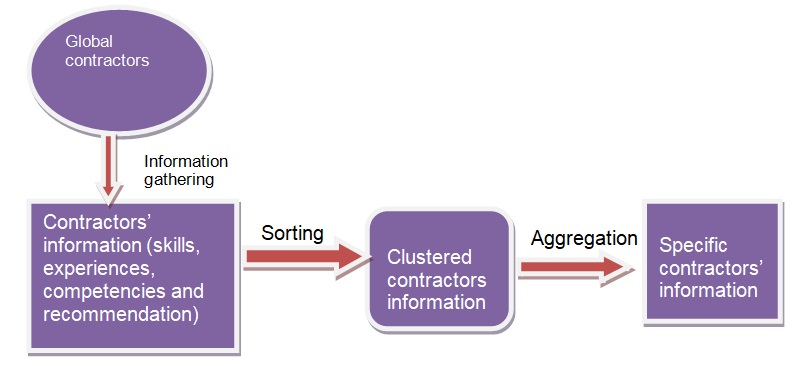
Discussion
Once the system is developed, all the stakeholders that will be affected by the system are invited to give their input about the organization to ensure the system meets their expectation. Some of the members that were involved include the procurement representatives, management, customers, contractors, suppliers and distributors. The ensuing discussion allows inclusion of omitted details and restructuring of some process to generate a perfect system that can reduce the burden shouldered by the procurement department. The discussion should also encompass the organization values; belief and culture are protected by the system. Enhancement of these allows the organization to generate a good rapport will the community and the environment in which the organization operates.
Implementation
This is the final step in system development and it consists in the system being applied. The implementation process should be done systematically to avoid operation disruption. The management can either implement the system partially to allow the staff to adjust themselves with the new system. The success of the system is vested on the ability of the management to connect the new system with the existing system. Since the new system is simpler, the management should combine the length details to fit into the new system. Checkland and Scholes (1990, p. 313) assert that Software System Method helps organizations to continue reflecting aspiration by evaluating its information strategy.
Illustration
This is a demonstration of how the organization can deal with the complex procurement process. In the diagram below, the procurement department organizes to meet all the distributors of various products who in turn provide their quotations for the products that they supply. The supplies’ lists are kept in a database that is queried to provide information both to the department and the stakeholders. On the other side, the contractors are also allowed to connect with the organization through online by completing their profile and they are expected to continue updating from time to time. These databases (consisting information on Suppliers, contractors and other stakeholders) are queried to provide the procurement department with up to date information, which they use to make decisions.
Criteria for Generation Contractors’ Information
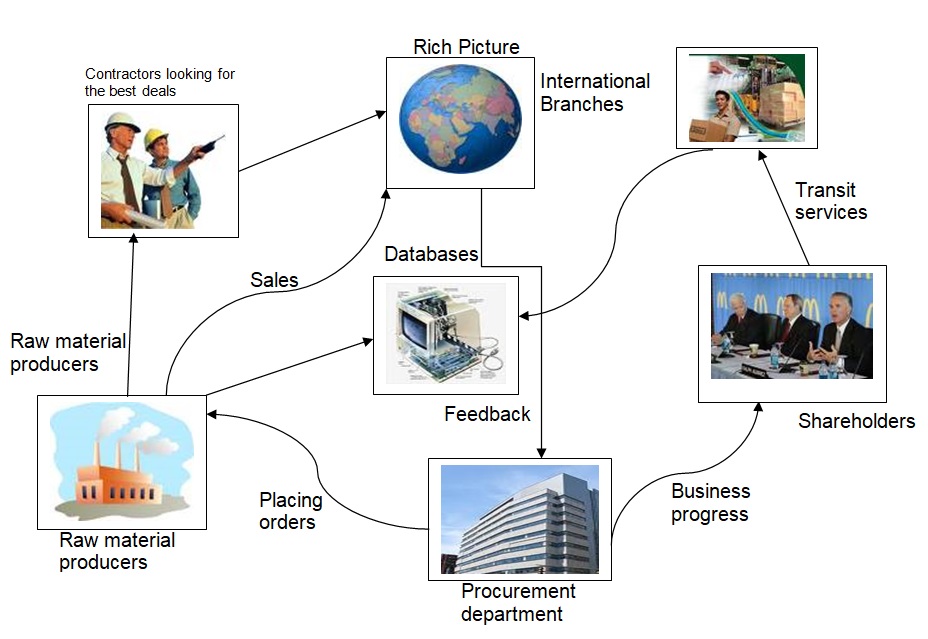
A Rich Picture Diagram Showing the Situation at Saudi Aramco
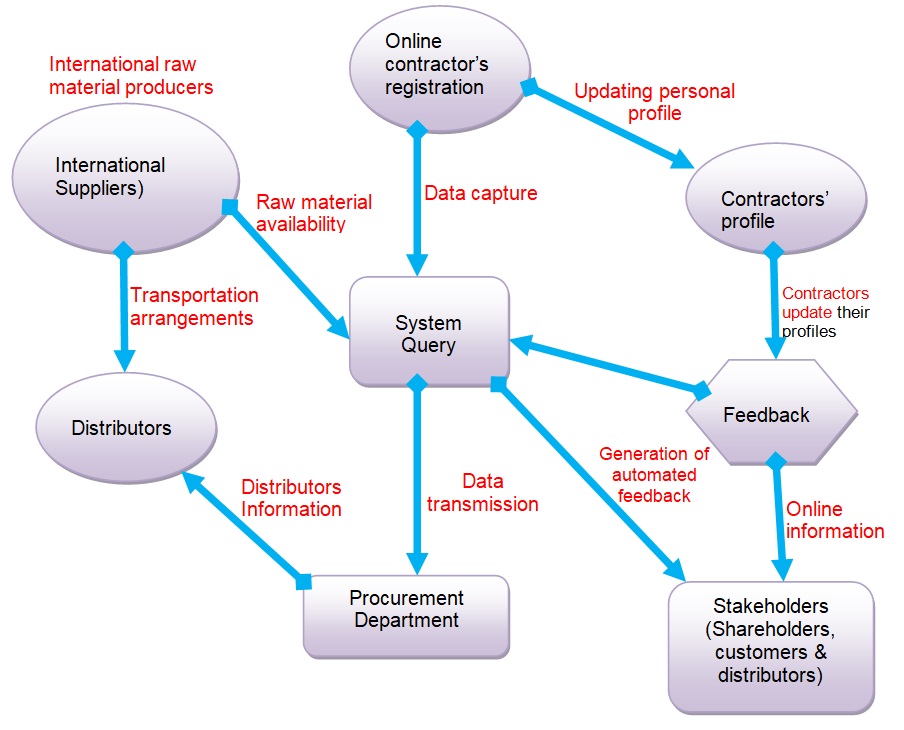
A Diagram Showing Conceptual Framework
Relationship between the Rich Picture Diagram and the Conceptual Model
The rich picture diagram presents the challenges that are being faced by the organization from several actors. The procurement department needs to link up with other branches that are located on various parts of the world. At the same time, both the contractors and distributors are seeking for the best deals for their services. Similarly, raw material producers strive to obtain manufacturers who are willing to pay higher prices for their material. As the complex scenario reveals, all agents seek to benefit from the services or the producers that they provide. Thus, the procurement has to acquaint with all the details that are available in the market before making any decision. Gathering all the relevant information is a laborious exercises that that cannot be done easily. Therefore, there is need to provide a system that can integrate all the information that is necessary.
Conversely, the conceptual model reflects the way the new system solves the problem presented by the big picture. The conceptual model automates some processes that allow both the raw material to update their quotation online and the department will just choose the best deal. On the same note, the contractors have a duty to create their online profiles, which the department is at liberty to consult and obtain the right specification for the available job. The computer when queried for a particular outcome processes all these databases. With the Software System Method, the organization will be able to meet the needs for its stakeholders without much ado. Furthermore, rather than relying on the procurement department, managers and shareholders are also in a position to observe the performance of the organization online. This system therefore will enhance speedy operation and organization growth will be boosted.
Values, Beliefs and Circumstances
Saudi Aramco is an organization that was found and continues to run on firm values that have formed an integral part of the firm’s culture. Implementation of this system will enhance the organization values both internally and externally. Since the organization appeals to a global market, development of strong values will enhance the organization reputation as well as its brand name. Similarly as the organization procurement process need to be streamlined so that operations and customers’ needs will be met with ease and more comfortably. The satisfaction that is experienced by the organization staff from the satisfaction of job will trickle down to the shareholders who will enjoy increased production due to increased transaction velocity. Moreover, stakeholders such as the government, suppliers and distributors will also benefit from the steady and reliable schedule.
Challenges
During the development of the system many challenges were experienced which hindered a smooth and expedite completion of the project. The main challenge that was experienced is the inability to access the internal information of the organization (all information used was retrieved from the internet). In addition, a time constraint hindered thorough investigation and analysis of the problem as well as carrying out benchmarks survey to understand how other organizations that have faced similar problems have managed to solve it. This problem made it difficult for me to design an operational system without having prior practical experience. Finally, there was also a challenge in integrating the theoretical skills acquired in class into a practical business atmosphere.
Personal Reflection
After a successful completion of the system, my personal understanding of developing systems to solve complex problems has improved a great deal. The experience has enabled me to transform the knowledge and skills obtained in the classroom into actual capacity develop systems that add value in an organization. Similarly, I have also become more enlightened on the need to incorporate all stakeholders and other parties, who are bound to be affected by developments in an organization as a strategy towards better results. Finally, apart from enhancing my self-belief, the project has motivated me to think of ways through which I can better my problem solving skills.
Report to the Client
After keen evaluation and analysis of the procurement process in the organization, I was moved to develop a system that would simplify the process. The system will help the organization to reduce the intricate processes that are applied by the organization. Additionally, to deal with the issue of a long bureaucracy, the new system will help reduce the number of persons required in decision-making. Thus, the new system is not only expected to expedite the entire procurement processes, it will also enhance the organization’s revenues due to increased operation velocity. Revenues are likely to grow because the organization will be able to increase the production process; bottlenecks in the procurement processes will be eliminated. On the same note, ability of the system to allow suppliers to update their quotation will save the organization the time wasted while struggling to obtain suppliers’ information.
The system designed has incorporated all the stakeholders of the organization i.e. the employees, suppliers, contractors, and management. The system, additionally, pays adequate attention to the environment that the organization operates. The aim of incorporating all these actors is to ensure the system is acceptable and all-inclusive. Since these people will be affected directly by the system, their involvement reduces chances of rejection and blatant defiance when system is implemented. Furthermore, their inclusion allows room for them to provide their input as well as diversifying the scope of the designer.
Lack of an online-based system in the existing procurement processes inhibits the organization to have up-to-date information about raw material availability and contractors’ details. However, this problem is addressed by the new system that endeavors to provide all relevant information concerning the suppliers to enhance smooth operations in the organization. Apart from enhancing information availability of relevant information, the new system will improve communication within the organization, especially among its international branches. The internet interface will connect all branches to the head office. Consequently, regional branches will be able to obtain timely information and transmit immediate feedback to the headquarters. As the communication is improved, the organization will benefit from good interpersonal skills that will be generated within the organization.
Since the main aim of developing the new system is to simplify the procurement process, the top management will have to work closely with the procurement department to facilitate a flawless implementation of the system. Although, this seems less necessary, joint incorporation of the organization in implementation of the system will boost its success. However, the incorporation of the organization goals and the strategic plan will help employees to internalize the organization’s mission, goals and strategic plan. A repetition of this exercise makes it possible for the organization to generate a working culture that is anchored on organizational values such as hard work and accountability.
Despite the good tidings presented by the system, the organization needs to remain vigilant to tackle issues arising due to implementation of the new system. Moreover, effort has to be put into upgrading the system and providing regular maintenance services. Moreover, since the organization is expanding drastically, the management should organize for follow up research to understand the effectiveness of the system. There is need to understand any gaps that exist in the system to allow timely amendments. As the organization expands, there is need for the organization to develop another administration system that will work jointly with the proposed system to improve the management of the organization (Hutchinson, 1997, p. 59). Finally, due to the swift change in the technological world, the management should strive to offer education facilities to their employees to keep them abreast and to enhance their ability of using new systems (Hutchinson, 1997, p. 125).
The Project Log
Week 1-4: Problem Reflection
After understanding the existing problem, I took time to reflect on the problem to provide a well thought out solution. As I thought, I developed a rich picture that formed a broad base for my reasoning and interpretation of the entire scenario and how well I could simplify the complex situation. Then I strived to evaluate all the stakeholders who will be affected by the system. It was also prudent to assess how each individual would be affected by the systems; the system has impacts to both the insiders and the outsiders. The broad perspective assumed enabled development of an all-inclusive system that accommodates all the shareholders of the firm.
Before embarking on the development of the system, I also endeavored to reflect on the existing knowledge level in the organization. This included assessing the impact the system would have on the stakeholders in the organization. A new system often tends to arouse confusion, prejudices, and skills deficits. In some other occasions, introduction of a new system renders redundant the existing operational proficiency. This analysis helped in developing a system that was acceptable and devoid of major hitches or that would cause organizational unrest. After conceptualizing everything, I devised various measures that would help to improve the procurement process, system outcome and overall organization production. Finally, I attempted to invoke organizational participation to anticipate and overcome rejection of the system when it is implemented.
Week 5-8: Organization Values and Human Characteristics
Since many people will utilize the system, it was important to assess the human behavior, related attitudes and polarities. The essence of including this is to foster a viable environment through which people can interact and relate freely. In this case, I opted to use the extrovert approach that would help in soliciting ideas, opinions and energy from the people. Apart from diversifying the scope, the extrovert approach enhances good interpersonal skills and therefore it was more useful in developing the system. Moreover, the approach improves self-identification, value, and fosters self-esteem.
The second thing that was done in the week is to look for ways of incorporating the various temperaments in the system as well as enhancing mutual understanding. From a wide the perspective, I strived to invoke the need to think about the other stakeholders and actors who are outside the organization. Incorporating stakeholders boosted my ability to develop the big picture and contextual framework. The remaining task was to develop a sketch of the plan that would allow fine-tuning and readjustment to best suit the organizational structure and scope of operation. The developed sketch served as a benchmark to compare current organization’s operations against the expected performance and thus it was possible to condense some processes
Week 9-12: Development of the Final System
After developing the sketch, the remaining task was to transform the draft system into an operational system. The main task at this point was to replace the hypothetical images with real life situations to depict the exact situation on the ground to foster system acceptability. Similarly, the rich picture diagram developed is tuned to meet the finer details that might have been omitted during the development of the sketch. This task was cumbersome since it prompted wide consideration and evaluation of all aspects that would affects the organization at large.
After development of the rich picture diagram, there was need to develop a conceptual model. The model illustrates the flow of activities from the procurement department to the system and finally to other actors such as the contractors, clients, international suppliers, and other international branches held by the firm. The model also works a manual of how the system operates and generates the feedback that is utilized by the operators and the managers. This conceptual model also reveals the processes, which are automated by the system and the input that is required to generate the expected outcome.
Finally, a linkage was developed between the big picture and the conceptual model to augment comprehension. This process was done systematically to avoid any misrepresentation of facts and operation sequences. Substantial effort was extended to provide recommendations for future changes and the adjustments that need to be effected. The future inclusion allows the organization to develop a system that would enhance future growth and expansion.
Overall Summary
The intricate nature of operations has often made many organizations to face challenges in dealing with the very nature of their operations. Similarly, inabilities for many organizations to contain these complexities not only slow down the organizational operations but they also limit the organization’s potential in the market. Therefore, any organization aspiring to increase its market command is compelled to engage in simplifying some of its compound processes. This may require combination or truncation of some activities to avoid redundancies and slow decision-making process. Although there are several methods of solving complex organization problem, just a few of them provide the required outcome. Thus, the management and the system designers should assess all the outcomes to select the best option.
The Saudi Aramco procurement department has been using a compound system that has really affected the output of the organization in general. However, after a thorough analysis of the problem, stringent measures and a workable organizational structure has been developed to revitalize the organization as a whole. The Soft System Method (SSM) has been identified as one of the best approaches for simplification of complex problems that face organizations. SSM allows the designer to engage all the stakeholders in the development of the organization’s operational system. An all-inclusive development processes is ideal given it fosters easier adoption of system; all the actors feel valued and incorporated in the system. The SSM combines several activities, which were initially done manually, to be processed by an automated system to generate a cohesive feedback.
During system development, understanding of the organizations objectives comes is critical. Additionally, since the organization works with people, considering the organizational culture becomes inevitable; it is only by considering it that one will be able to promote employee focus and ability to meet the present goals. For that reason, the system developer needs to integrate the two during the development of the big picture diagram and equally in the conceptual model. After developing the conceptual model, the system needs to be implemented to serve the intended purpose. However, care should be borne during implementation to avoid operation interruption and loss of historical data that defines the organization’s operations.
The experience gained during this system development has increased my ability to conceptualize a broad problem and design the appropriate measures to allow formulation of simplified solutions. The challenges encountered have built my capacity to tackle complex problems. In addition, this challenge has provided an insight to me that have allowed me to discover complex issues in an organization and provide viable solutions. In addition, the successful design has increased my impetus to indulge in problem simplification. The experience has motivated me to increase my problem solving skills for the sake of better performance in the future.
Although the Software System Method has been hailed for its ability to provide solution to most of the complex problems, it has also received its fair share of criticism. Jackson (1992, p. 168) argues that the SSM mainly works in favor of the existing power rather catering for the needs of all actors in the organization. Despite these complaints, effective design and implementation of the system provides one of the best solutions to any complex problem.
References
Checkland, P., & Scholes, J., 1990. Soft Systems Methodology in Action. Biddles Ltd: Salisbury.
Forbes, P. 1995. Strategic Thinking: A Role for Soft Systems Methodology.
Hutchinson, W., E., 1997. Systems Thinking and Associated Methodologies. Praxis Educational: Quins Rock, Australia.
Jackson, M., C., 1982. “The Nature Of “Soft” Systems Thinking: The Work of Churchman, Ackoff and Checkland”, Journal of Applied Systems Analysis, 9 (2) pp.17-29.